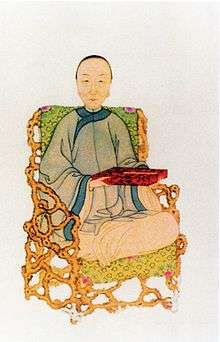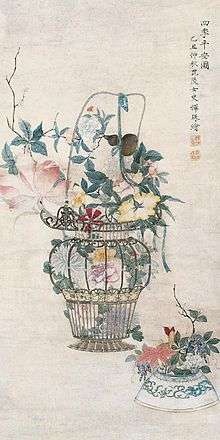Yun Zhu
Yun Zhu or Wanglan Yun Zhu aka Adept of the Lotus Lake (29 July 1771 – 1 June 1833) was a Qing dynasty poet, painter, anthologist and moralist.[1] She gathered together thousands of poems written by hundreds of women.[2]
Yun Zhu | |
|---|---|
 | |
| Born | Yun Zhu 29 July 1771 Yanghu, Changzhou province |
| Died | 1 June 1833 |
| Nationality | Qing dynasty |
| Spouse(s) | Wanyan Tinglu |
| Children | 4 |
Life
She was born in 1771 into an artistic family in Yanghu in Changzhou. Her aunt, Yun Bing, was a skilled artist.[3] and her great grandfather, Yun Shouping, was a renowned painter.[3] During her birth her grandmother had a dream that a stranger gave her a large shining pearl. Taking this as a sign she was called "Zhu" the word for pearl.[4]
Her father was a jailer but she married Wanglan Tinglu who was a Manchu aristocrat. They had four children Wanyan Linqing in 1791, Wanyan Linchang in 1792, Wanyan Linshu in 1794 and a daughter the following year.[3]

She wrote and collected poems. Her favourite son Linqing discovered that his mother had collected over 3,000 poems by women during her childhood and as an adult.[5] Possibly without her consent Linqing arranged for some to published in 1814. Yun was annoyed as she felt that only poems intended for posterity should be published. Her Drafts poems and Lyrics from Hongxiang Library went to be reprinted in 1866 and 1928.[3]
She restarted her life at the age of 50 following the death of her husband in 1820, the year before. She took a pen name of Adept of the Lotus Lake.[5] She went to live with her son and this meant that we know of her life from his autobiography. He was an expert in water conservation in Anhui province. When he moved from the Huizhou prefecture, she wanted to travel via the sights of Xin'an, so she wanted a route through the Dahong mountain. Linqing obliged and he led the way giving her a commentary. Linqing decided to get a painting made of her following his lead up steep mountain paths in a sedan chair.[5]
Her pre-eminent work was a book of poetry called Women's Poetry: anthology for a Correct Beginning. The book included 933 different authors and 1,700 poems. It took twenty years to complete and it included poets from Korea and Mongolia. Yun was able to travel widely as accompanied her father on his business trips. The proof reading of the book was completed by her granddaughters and her daughters in law.[3]
She was known as "Dame dowager of the first rank" and had been given other honours by the Imperial court. She taught three sons and fourteen grandchildren before she died in 1833.[3] She died without her favourite son ashehadbeen ordered by the emperor to become the Governor of Guizhou. This was a challenge for Linqing as he did not want to leave. However fear of bandits and of disobeying the emperor meant that he had to journey alone. His split loyalties are shown in the paintings and poetry he created en route.[2] After she died Linqing took her remains to Beijing for burial.[4]
References
- Yun Zhu, Oxford Reference, Retrieved 17 November 2016
- Kam Louie (1 June 2016). Changing Chinese Masculinities: From Imperial Pillars of State to Global Real Men. Hong Kong University Press. pp. 122–. ISBN 978-988-8208-56-2.
- Lily Xiao Hong Lee; Clara Lau; A.D. Stefanowska (17 July 2015). Biographical Dictionary of Chinese Women: v. 1: The Qing Period, 1644-1911. Taylor & Francis. pp. 358–. ISBN 978-1-317-47587-3.
- Xun, Liu. "Immortals and Patriarchs:The Daoist World of a Manchu Official and His Family in Nineteenth Century China" (PDF): 179. Retrieved 17 November 2016. Cite journal requires
|journal=(help) - Susan Mann (1997). Precious Records: Women in China's Long Eighteenth Century. Stanford University Press. pp. 94–99. ISBN 978-0-8047-2744-0.